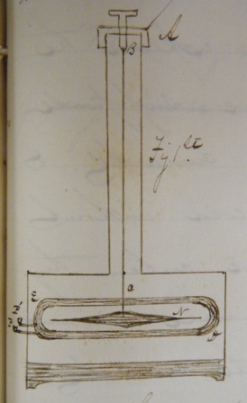Below is an excerpt from the notebook. Professor Henry explained first the non-astatic, and then the astatic galvanometer. He uses the terms “simple” and “compound” galvanometers for each, respectively.
simple

“There are two forms of the instrument [the galvanometer] called the simple and compound. The first replicated in Fig 1st consists of [a] large coil of wire ED rolled upon itself and insulated with silk or wax, in this a needle N is suspended by a silk thread BC from a movable head A. The two ends of the copper wire coil terminate in two cups PP’ containing a little mercury in order that they may be united with the poles of a battery when a current is required to be tested, and the whole is covered with a glass case.”
compound

“The compound galvanometer differs from the simple, only in having a greater number of needles. By this means we not only neutralize the magnetic influence of the earth, but also make the instrument more sensitive. These needles are suspended by a thread fastened to a straw ab or some other light substance into which the needles are placed.” -Daniel Ayres Jr.’s Student Notebook, lecture notes from Joseph Henry’s Natural Philosophy class, 1841